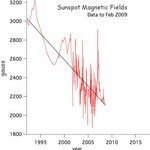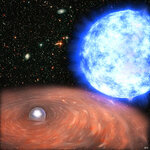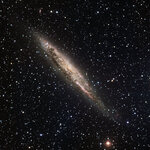Space

NASA's 19-year-old Hubble Space Telescope still has a few tricks up its sleeve! New images were released today from Hubble's new Wide Field Camera 3. Installed back in March, WFC3 extends Hubble's capabilities well into the infrared, allowing it to peer through dust and see further back in time. For a stunning demonstration, click here.
Shown below are the featured new images, taken in ultraviolet, visible, and infrared light all with WFC3:NGC 6302: remnants of a dying starStephan's Quintet: 5 galaxies enwtined in a cosmic danceOmega Centauri: 100,000 stars resolved in…

Old notion: Giant clouds of gas and dust to collapse inward due to gravity, growing denser and hotter until igniting nuclear fusion and forming stars. New notion: It's more than just gravity and cosmic magnetic fields play a more important role in star formation than previously thought.
A molecular cloud is a cloud of gas that acts as a stellar nursery. When a molecular cloud collapses, only a small fraction of the cloud's material forms stars but scientists aren't sure why.
Gravity favors star formation by drawing material together, therefore some additional force must…

We have been in an anomalously long Solar Minimum. The sun has an 11 year cycle from Minimum to Maximum. But the cycles are (like most things in nature) not exact, and some are longer than the others. We are coming out of Solar Minimum... or are we?
Even in the midst of our current cycle, solar physicists were predicting a long minimum, and, humorously, seemed evenly divided over whether this meant we would have a more active Maximum, or a far less active Maximum. For example, David Hathaway in the NASA article "Solar Cycle 25 peaking around 2022 could be one of the…

ESA's XMM-Newton orbiting X-ray telescope has uncovered the first close-up of a white dwarf star, circling a companion star, that could explode into a particular kind of supernova.
Well, in a few million years.
Astronomers use these supernovae as beacons to measure cosmic distances and could one day help us understand the expansion of the Universe. They've been on the trail of this particular mystery object since 1997 when they discovered that something was giving off X-rays near the bright star HD49798. Now the mysterious object has been tracked along its orbit and observation has…

Welcome to Traceback, where I find articles other people have written on Project Calliope. Having publically announced less than a week ago and with just 2 pieces written, I can safely paraphrase Oscar Wilde: the only thing worse than being blogged about, is not being blogged about. And indeed we are blogged about.
Jon Newton at P2PNet had the news out before anyone at "Music from space ready for lift-off! (Literally.) Thanks for the early lead, Jon!
David Noel calls us 'badass-cool' at Echolot. Okay, that made my day, equalling a private message from a friend calling…

NASA's Jet Propulsion Laboratory was closed Monday as wildfires came within two miles of the facility. The decision to give most of the 5,000 employees the day off was made Sunday evening. At that point the fire was no longer a threat to the lab (you think they'd let a government lab burn down?), but the air quality was very poor. Only mission-critical personnel reported to work.
Lab reopened Tuesday, but I continued to work from Caltech until today, Thursday. The air at JPL was still smoky, though by now not much worse than at Caltech or at my home in Glendale.
A…

A TubeSat picosatellite lifts 200 grams of payload. That's about 7 ounces. Looked at one way, that's less than half a can of soda. But it's enough to lift an entire Nintendo DS game handheld into orbit. 200 grams can be a lot of electronics.
When I committed to this project, I didn't yet have the specific electronics in mind. I've built mini guitar amps and guitar sound processors that come in well under 7 ounces. I assumed I could kit-bash stuff and create my own schematics for the final assembly. What I didn't expect was that there would be a company that already builds everything I need.…

A new image of nearby galaxy NGC 4945 shows that it looks a lot like our own Milky Way.
NGC 4945 seems to be a spiral galaxy with swirling, luminous arms and a bar-shaped central region, though NGC 4945 has a brighter center that likely harbors a supermassive black hole which is devouring reams of matter and blasting energy out into space.
As NGC 4945 is only about 13 million light-years away in the constellation of Centaurus (the Centaur), a modest telescope is sufficient for skygazers to take a look. NGC 4945’s designation comes from its entry number in the New General Catalogue compiled…

A giant galaxy, so distant that it is seen as it was 12.8 billion years ago, is as large as the Milky Way and contains a supermassive black hole with at least a billion times as much matter as our Sun.
The discovery, in a paper in the journal Monthly Notices of the Royal Astronomical Society by University of Hawaii astronomer Dr. Tomotsugu Goto and colleagues, lays claim to the most distant supermassive black hole ever found.
Knowledge of the host galaxies of supermassive black holes is important in order to understand the mystery of how galaxies and black holes have evolved together. Until…

This here, "The Sky By Day", is my science writing column. I write about current news and cultural issues in space and computer science. Very simple, very journalistic:
See Alex write. Write, Alex, write!
I have started a new project, to launch a satellite into space. It's called Project Calliope, and myself and my team will write about it here at SB here in the new column, Satellite Diaries:
See Alex do science. Sciencify, Alex, sciencify!
Okay, maybe 'sciencify' is not a word. But do check out Project Calliope, and sign up for…